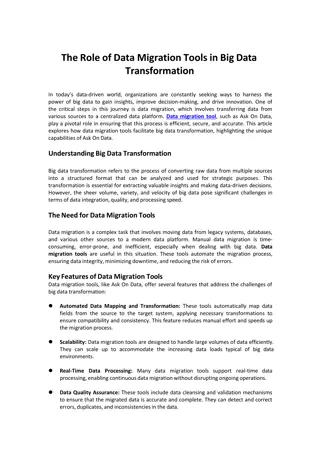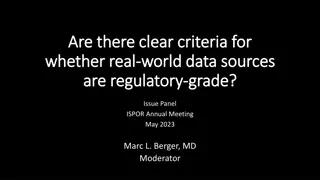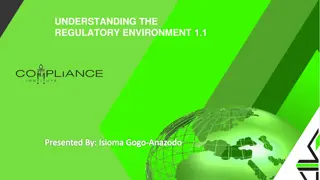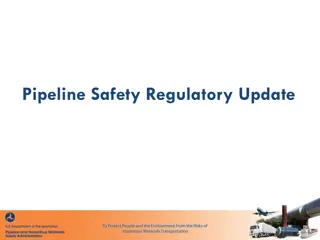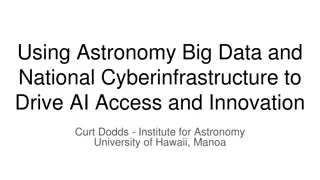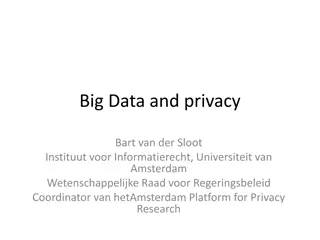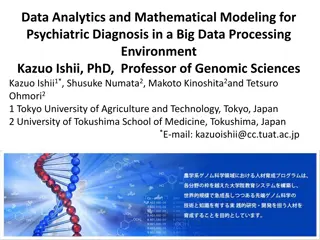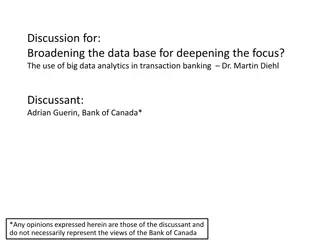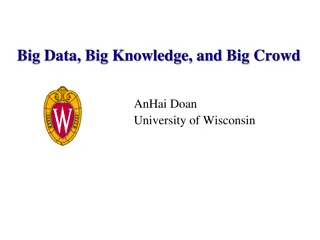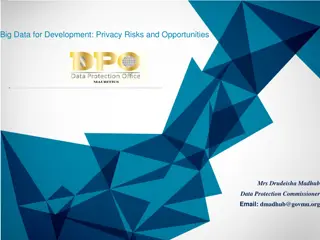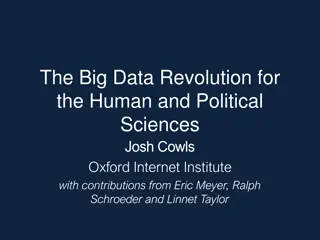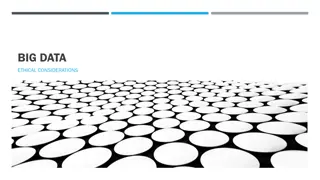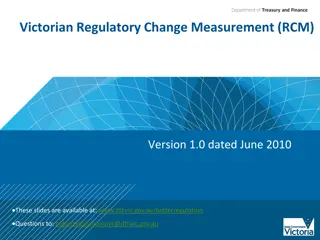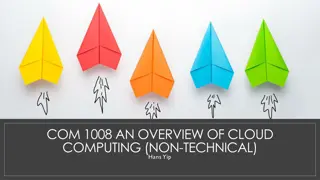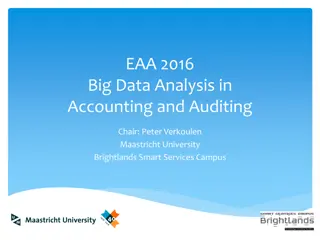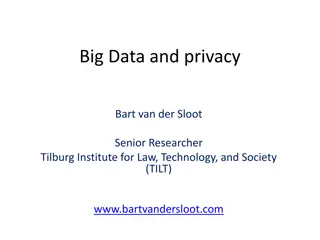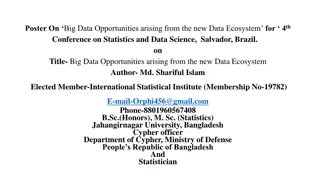Exploring Regulatory Challenges and Opportunities in Big Data Applications
Discussing the regulatory perspective on commercial versus humanitarian and development applications of big data, this conversation with regulators highlights the differences and similarities in utilizing data for various sectors. Emphasizing the importance of trust, confidentiality, and data security, the overview addresses the sensitive nature of big data and the need to maintain customer trust amidst legal and cultural changes. It also delves into the aspect of big data regulations and the intersection of big data with humanitarian efforts, offering insights on leveraging data for better service delivery to vulnerable communities.
Download Presentation

Please find below an Image/Link to download the presentation.
The content on the website is provided AS IS for your information and personal use only. It may not be sold, licensed, or shared on other websites without obtaining consent from the author. Download presentation by click this link. If you encounter any issues during the download, it is possible that the publisher has removed the file from their server.
E N D
Presentation Transcript
Challenges & Opportunities from the Regulatory Perspective, a conversation with regulators, discussing the differences and similarities between commercial vs humanitarian and development applications of big data. Mrs Drudeisha Madhub Data Protection Commissioner Email: dmadhub@govmu.org
Overview Big data provides an enormous upside for humanitarian and development sector. By supplying granular insight into consumer behaviors and habits, it enables companies to better develop new products and services, improve existing offerings, reinforce relationships with consumers, and boost revenue. Big data enables the different sectors to unlock value from the ever-growing stream of data on consumer behavior and habits. But the use of big data is sensitive by nature, because it often relies on processing personal information.
Trust It is very important to guarantee confidentiality, data security, transparency, and control over data. The winning strategy for different sectors using big data will be to stay current on legal and cultural changes and to maintain customer trust. Data subjects need to trust that their personal data is protected. Without such confidence, it might be a lost for future economic and social value.
Aspect of Big Data The first aspect of Big Data regulations, which should be taken into account while formulating a Big Data policy framework, is not to hinder investments by giving operators and Internet service providers the ability to easily explore and tap into new revenue streams, such as the ones resulting from Big Data. Technology is moving so quickly and governmental legislative bodies move so glacially, that regulation will likely always lag behind. That doesn't mean that companies are off the hook when it comes to personal data and privacy regulation.
Big data and Humanitarianism Humanitarian organisations are trying to come to terms with how the ocean of information can help them deliver better services to vulnerable communities. Here are five things you need to know about big data and humanitarianism:- 1. Finding ways to make big data useful to humanitarian decision makers is one of the great challenges, and opportunities. Access to near real-time information can help humanitarian organizations provide more targeted assistance and become more responsive to needs as they evolve. 2. Humanitarians can draw inspiration from their development partners. There is already a lot of work being done that humanitarians could easily capitalize on.
Big data and Humanitarianism 3. Gettingaccess to data is not necessarilystraightforward. Social media is one source of big data in which access is easier because much of the information is already public. For example, within 24 hours of Typhoon Bopha hitting the Philippines at the end of 2012, the Digital Humanitarian Network was able to categorize 20,000 social media messages to create a map of the storm s impact. 4. Big data should complement existing sources of information, not replace them. Big data, especially when generated by social media, has its limitations. There are obvious concerns about bias; in developing contexts where internet access is limited, data drawn from Twitter probably over-represents urban elites. But bias in data is not new, and there are methods of balancing or correctingit.
Big data and Humanitarianism 5. We cannot assume that better data will necessarily lead to better decision-making. Big Data, the argument goes, should lead to better and more informed decision-making. But unfortunately, decisions are not always driven by evidence. For example, lets take the 2011 famine in the Horn of Africa. As early as 2010, many UN and humanitarian organisations were warning about the looming food crisis.
Data Innovation: big data and technologies development The world of data changes every day and every hour. New innovations and developments have hugely increased the quantity of data and the possibilities available to people and institutions who want to collect and use it. challenge, and the opportunity, is to make this new world of data useful and useable to improve people s lives. The Example:- In 2014, the developing world accounts for more than of the world mobile phone subscriptions.
Data Innovation: Private Sector Today, in the private sector, analysis of big data data sets too large and complex to be studied without software- is commonplace with consumer profiling, personalised services, and predictive analysis being used to optimise sales. Similar techniques could be adopted to gain real-time insights into people s wellbeing interventions to vulnerable groups. Such innovations offer exciting new opportunities, but also throw up big challenges around privacy, public trust, and the potential abuses of data. Legal frameworks have not yet caught up with rapidly advancing technology. and to target aid
Data Innovation: Public Sector Public sector bodies are also starting to use big data and new technologies. Public health researchers are gaining valuable insights from using anonymised mobile phone data on human migration and linking this to the spread of malaria and dengue fever.
Data Innovation: Opportunity The increasing use of internet-enabled devices with sensors will provide still more opportunities both to improve the way services are delivered and also to harness that data to gain faster insights into whether interventions are working. Mobile technology services are also drivers of information that can empower citizens, be it apps that tell farmers when to optimally plant crops, micro-loans for fledgling enterprises or medical information for front-line health practitioners in remote settings.
How the opportunities of emerging technology and methodologies can best be realised for public good. In particular: Creating incentives and regulatory structures to encourage private enterprises to share data and pilot new ways of working. Encouraging links between public and private sectors to research new methods, pilot their use, and encourage dissemination. Developing privacy frameworks that protect the privacy of individuals without hampering life-saving uses of data science for public good Capacity-boosting on new sources of data and the use of new technologies in the field of international development, humanitarian assistance and statistics.
How the opportunities of emerging technology and methodologies can best be realised for public good. Examples of new innovations and methods that have demonstrated potential for improving the frequency, reliability, accessibility and usefulness of data. Examples of success in bringing together official and non-official data sources, and traditional and non-traditional methods. What are the factors behind the success stories, and what have been some of the challenges? Supporting widespread adoption of new and innovative ways of working where proven effective.
How the opportunities of emerging technology and methodologies can best be realised for public good. Examples of new innovations and methods that have demonstrated potential for improving the frequency, reliability, accessibility and usefulness of data. Examples of success in bringing together official and non-official data sources, and traditional and non-traditional methods. What are the factors behind the success stories, and what have been some of the challenges? Supporting widespread adoption of new and innovative ways of working where proven effective.
Conclusion Developing technologies services are drivers of information that can empower citizens, be it apps that tell farmers when to optimally plant crops, micro-loans for fledgling enterprises or medical information for front-line health practitioners in remote settings. The overflow of information generated, for example, during disasters can be as paralyzing to humanitarian response as the lack of information. The flash flood of information social media, satellite imagery and more is often referred to as Big Data. Making sense of this data deluge during disasters is proving an impossible challenge for traditional humanitarian organizations, which explains why they re turning to Digital Humanitarians.
References References: https://www.crcpress.com http://www.undatarevolution.org https://www.bcgperspectives.com https://blogs.oracle.com





